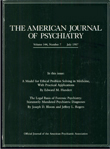Cerebral Phosphate Metabolism in First-Degree Relatives of Patients With Schizophrenia
Abstract
OBJECTIVE: Most phosphorus-31 magnetic resonance spectroscopy (31P-MRS) studies have described measures of lower membrane anabolism or greater catabolism in the frontal lobes of patients with schizophrenia. The purpose of the present study was to evaluate whether these findings can also be detected in young subjects at genetic risk for schizophrenia. METHOD: Fourteen children and siblings of patients with schizophrenia (mean age=16.7 years) and 14 comparison subjects (mean age=16.9 years) were included in a 31P-MRS study of the frontal lobe. RESULTS: The high-risk subjects had significantly lower mean ratios of phosphomonoesters to phosphodiesters (0.25 versus 0.31) and higher mean phosphodiester values (37.59% versus 34.87%) than comparison subjects. CONCLUSIONS: These findings suggest greater phospholipid breakdown even in young first-degree relatives of patients with schizophrenia. This suggestion is discussed with respect to the membrane phospholipid hypothesis of schizophrenia.



